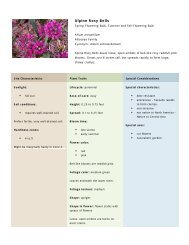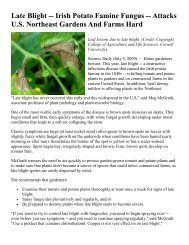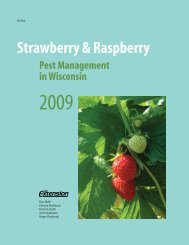Growing Blackberries in Your Home Garden, EC 1303 (Oregon ...
Growing Blackberries in Your Home Garden, EC 1303 (Oregon ...
Growing Blackberries in Your Home Garden, EC 1303 (Oregon ...
- No tags were found...
Create successful ePaper yourself
Turn your PDF publications into a flip-book with our unique Google optimized e-Paper software.
Black Diamond.Dig, plow, or rototill the material <strong>in</strong>to thesoil to ensure that it will be well decomposed byplant<strong>in</strong>g time. If you <strong>in</strong>corporate large amounts ofnondecomposed material <strong>in</strong>to the soil, add2 lb calcium nitrate (16 percent nitrogen) per100 sq ft to aid <strong>in</strong> decomposition.If your garden is slow to dra<strong>in</strong>, or if the watertable is high, you can <strong>in</strong>stall a dra<strong>in</strong> tile near therow (at least 25 <strong>in</strong>ches deep) or plant on raisedbeds.Spac<strong>in</strong>gFor trail<strong>in</strong>g cultivars, space plants 4 to 6 feetapart <strong>in</strong> the rows. Space erect cultivars 2 to 3 feetapart and semierect cultivars 5 to 6 feet apart.Leave about 10 feet between rows.Plant<strong>in</strong>gIt’s best to purchase certified disease-freeplants from a nursery. Plants from a neighbor’splant<strong>in</strong>g could <strong>in</strong>troduce root-rot organisms,viruses, or other pests <strong>in</strong>to your garden. Traditionally,plants were sold as fairly large “bare-root”plants, but tissue-cultured plants are becom<strong>in</strong>gmore common. These plants are lush and tenderand are sold <strong>in</strong> small cell packs.If you can’t plant immediately, bury plant roots<strong>in</strong> moist soil or sawdust to prevent dry<strong>in</strong>g.To propagate cultivars that produce suckers,simply transplant rooted suckers. Propagate trail<strong>in</strong>gcultivars, which produce fewer root suckers,by tip layer<strong>in</strong>g. Cover tips of canes with soil <strong>in</strong> thelate summer or early fall. Cut rooted tips from thecanes and transplant them the follow<strong>in</strong>g spr<strong>in</strong>g.Plant as early as you can work the soil <strong>in</strong>the spr<strong>in</strong>g. Dig a shallow hole, large enough toaccommodate the roots. If you have bare-rootplants, spread the root mass and set the plant sothat the highest po<strong>in</strong>t of attachment of roots tocane is 1 to 1 1 ⁄2 <strong>in</strong>ches below ground level. Coverwith soil and press firmly to remove air pockets.Water the plants to settle the soil. Cut the canes onnewly set bare-root plants to 6 <strong>in</strong>ches at plant<strong>in</strong>gtime. Tissue-cultured plants need more care afterplant<strong>in</strong>g and should be treated like a vegetabletransplant; plant them at about the same depth asthe conta<strong>in</strong>er (or slightly deeper) and water themfrequently until established.TrellisIt’s advisable to trellis all blackberries. Youcan grow erect blackberries without support, buttrellises help prevent cane breakage from w<strong>in</strong>d,keep the plant<strong>in</strong>g neater, and make cultivation andharvest<strong>in</strong>g easier.Trail<strong>in</strong>g blackberries. This type of blackberryis easy to grow on a simple two-wire trellis. Use8-foot or longer wooden end posts. Bury one endof each post, leav<strong>in</strong>g 6 feet above ground. Placemetal posts every 20 feet <strong>in</strong> the row. Run a topwire almost 6 feet above ground and a lower wire4 1 ⁄2 feet above ground (Figure 1). Use high- tensilewire and <strong>in</strong>stall tighten<strong>in</strong>g devices at one end ofthe row. In the plant<strong>in</strong>g year, tra<strong>in</strong> new primocanes18"4.5 to 6'B20 to 30' between postsAFigure 1. Two-wire trellis for trail<strong>in</strong>g blackberries, <strong>in</strong>the grow<strong>in</strong>g season (leaves and fruit<strong>in</strong>g laterals notdrawn for clarity): (A) Floricanes that just bore fruit andwill die. (B) Wire guide for new cane growth. (C) Newprimocane growth that will bear fruit the follow<strong>in</strong>g year.C3












